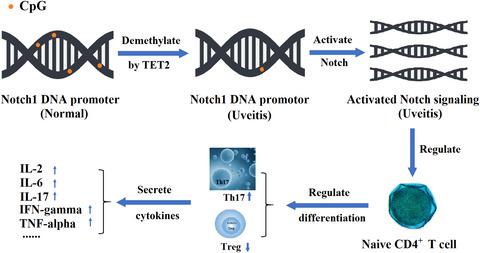当前位置:
X-MOL 学术
›
Clin. Exp. Immunol.
›
论文详情
Our official English website, www.x-mol.net, welcomes your feedback! (Note: you will need to create a separate account there.)
Hypomethylation of Notch1 DNA is associated with the occurrence of uveitis.
Clinical & Experimental Immunology ( IF 4.6 ) Pub Date : 2020-06-01 , DOI: 10.1111/cei.13471 H Wei 1 , X Yin 1 , H Tang 1 , Y Gao 2 , B Liu 3 , Q Wu 4 , Q Tian 4 , Y Hao 1 , H Bi 2 , D Guo 2
Clinical & Experimental Immunology ( IF 4.6 ) Pub Date : 2020-06-01 , DOI: 10.1111/cei.13471 H Wei 1 , X Yin 1 , H Tang 1 , Y Gao 2 , B Liu 3 , Q Wu 4 , Q Tian 4 , Y Hao 1 , H Bi 2 , D Guo 2
Affiliation

|
Uveitis is a serious intra‐ocular inflammatory disease that can lead to visual impairment even blindness worldwide. Notch signaling can regulate the differentiation of naive CD4+ T cells, influencing the development of uveitis. DNA methylation is closely related to the autoimmune diseases. In this study, we measured the Notch1 DNA methylation level, determined the Notch1 and related DNA methylases mRNA expression and evaluated the ratio of T helper type 17 regulatory T cell (Th17/Treg) in peripheral blood mononuclear cells (PBMCs) from uveitis patients and normal control subjects; we also tested the levels of relevant inflammatory cytokines in serum from the participants. Results indicated that compared with those in normal control individuals, the expression of ten–eleven translocation 2 (TET2) and Notch1 mRNA is elevated in uveitis patients, whereas the methylation level in Notch1 DNA promotor region [−842 ~ −646 base pairs (bp)] is down‐regulated, and is unrelated to anatomical location. Moreover, the Th17/Treg ratio is up‐regulated in PBMCs from uveitis patients, accompanied by the elevated levels of proinflammatory cytokines [e.g. interleukin (IL)‐2, IL‐6, IL‐17 and interferon (IFN)‐γ] in serum from uveitis patients. These findings suggest that the over‐expression of TET2 DNA demethylase may lead to hypomethylation of Notch1, activate the Notch1 signaling, induce naive CD4+ T cells to differentiate theTh17 subset and thus disturb the balance of the Th17/Treg ratio in uveitis patients. Overall, hypomethylation of Notch1 DNA is closely associated with the occurrence of uveitis. Our study preliminarily reveals the underlying mechanism for the occurrence of uveitis related to the hypomethylation of Notch1 DNA, providing a novel therapeutic strategy against uveitis in clinical practice.
中文翻译:

Notch1 DNA 的低甲基化与葡萄膜炎的发生有关。
葡萄膜炎是一种严重的眼内炎症性疾病,可导致世界范围内的视力障碍甚至失明。Notch信号可以调节幼稚CD4 + T细胞的分化,影响葡萄膜炎的发展。DNA甲基化与自身免疫性疾病密切相关。在本研究中,我们测量了 Notch1 DNA 甲基化水平,测定了 Notch1 和相关 DNA 甲基化酶 mRNA 的表达,并评估了 T helper 17 型调节性 T 细胞(Th17/T reg) 在葡萄膜炎患者和正常对照受试者的外周血单核细胞 (PBMC) 中;我们还测试了参与者血清中相关炎性细胞因子的水平。结果表明,与正常对照个体相比,葡萄膜炎患者中10-11易位2(TET2)和Notch1 mRNA的表达升高,而Notch1 DNA启动子区[-842~-646碱基对(bp )] 被下调,并且与解剖位置无关。此外,Th17/T reg葡萄膜炎患者 PBMC 中的 β 比值上调,伴随葡萄膜炎患者血清中促炎细胞因子 [例如白介素 (IL)-2、IL-6、IL-17 和干扰素 (IFN)-γ] 水平升高。这些发现表明 TET2 DNA 去甲基化酶的过度表达可能导致 Notch1 的低甲基化,激活 Notch1 信号,诱导幼稚 CD4 + T 细胞分化 Th17 亚群,从而扰乱葡萄膜炎患者Th17/T reg比率的平衡。总的来说,Notch1 DNA的低甲基化与葡萄膜炎的发生密切相关。我们的研究初步揭示了与Notch1 DNA低甲基化相关的葡萄膜炎发生的潜在机制,为临床实践中的葡萄膜炎提供了一种新的治疗策略。
更新日期:2020-06-01
中文翻译:

Notch1 DNA 的低甲基化与葡萄膜炎的发生有关。
葡萄膜炎是一种严重的眼内炎症性疾病,可导致世界范围内的视力障碍甚至失明。Notch信号可以调节幼稚CD4 + T细胞的分化,影响葡萄膜炎的发展。DNA甲基化与自身免疫性疾病密切相关。在本研究中,我们测量了 Notch1 DNA 甲基化水平,测定了 Notch1 和相关 DNA 甲基化酶 mRNA 的表达,并评估了 T helper 17 型调节性 T 细胞(Th17/T reg) 在葡萄膜炎患者和正常对照受试者的外周血单核细胞 (PBMC) 中;我们还测试了参与者血清中相关炎性细胞因子的水平。结果表明,与正常对照个体相比,葡萄膜炎患者中10-11易位2(TET2)和Notch1 mRNA的表达升高,而Notch1 DNA启动子区[-842~-646碱基对(bp )] 被下调,并且与解剖位置无关。此外,Th17/T reg葡萄膜炎患者 PBMC 中的 β 比值上调,伴随葡萄膜炎患者血清中促炎细胞因子 [例如白介素 (IL)-2、IL-6、IL-17 和干扰素 (IFN)-γ] 水平升高。这些发现表明 TET2 DNA 去甲基化酶的过度表达可能导致 Notch1 的低甲基化,激活 Notch1 信号,诱导幼稚 CD4 + T 细胞分化 Th17 亚群,从而扰乱葡萄膜炎患者Th17/T reg比率的平衡。总的来说,Notch1 DNA的低甲基化与葡萄膜炎的发生密切相关。我们的研究初步揭示了与Notch1 DNA低甲基化相关的葡萄膜炎发生的潜在机制,为临床实践中的葡萄膜炎提供了一种新的治疗策略。


























 京公网安备 11010802027423号
京公网安备 11010802027423号